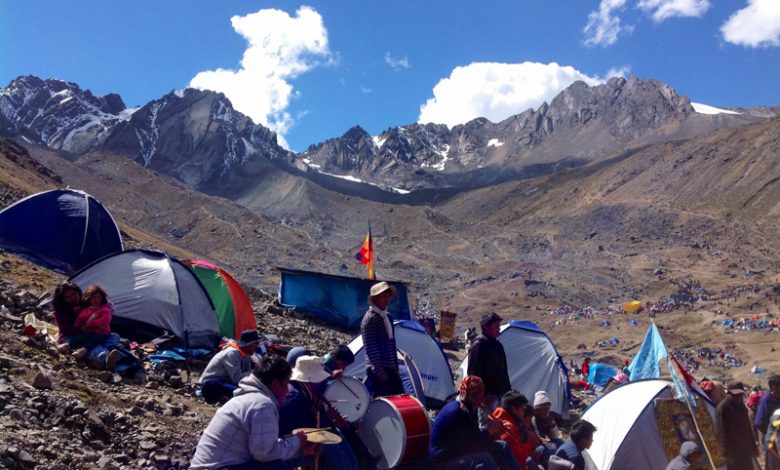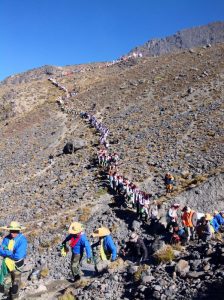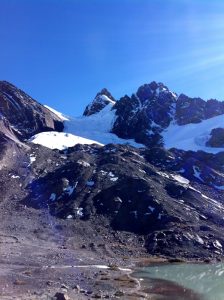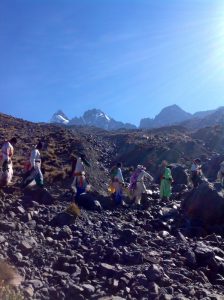
At the entrance of the sanctuary mamita Alexandrina asks me where I will camp. I realize that we are at the end of a long line leading to the temple, a recently constructed church on the valley floor. ‘I would find a place somewhere’ I says. Mamita asks a couple in the line in front of us where I should camp. They say that no more people are allowed to camp above us or on the opposite side of the valley. Mamita tells me I look tired and should find a place to pitch my tent. I ask mamita where she would stay, “In the temple” she says. I say my good byes knowing mamita is safe with her people. I make my way through the main camp walking carefully on the wet, spongy pampas covering the valley floor. The main encampment was chaotic yet orderly. Fireworks exploded all around illuminating the valley and the glacier covered peaks above us. I climbed a way up the opposite side of the rocky valley wall into one of the many encampments.I am greeted by a friendly Spanish research scientist. He tells me I can find a spot further up the valley, away from the main encampment.

There is just enough light allowing me to make my way through the encampment and up the valley wall until I am above most of the noise and confusion. I find the secluded camp of the Sicauni community, a large indigenous village beyond Pitumarka, my adopted village. I notice a somewhat level site carved out of the scree.Close by, I see men sitting around a fire near a round rocky shrine of burning candles and ask if I could pitch my tent. In very broken Spanish I am told that this is a private encampment. Two other men in a nearby tent stick their heads out and apparently reprimand their friends in Quechua and tell me I can pitch my tent. To be sure, I ask again and they say Its fine. Grateful I carefully set up my tent in the dim light and put away my things. The noise and explosions of light coming from the hundreds of dance troupes and pyrotechnics is chaotic and continues throughout the night. Just when I am falling asleep, dancers from my encampment rousing their comrades as it is time to perform.

After a long, frigid night on the rocks, light begins to illuminate the sky. I awake to see the amazing moonscape and massif of glacier covered peaks surrounding us. Below me is a great sprawl of tents, activity, confusion and smoke. Immediately below me I see a group of older women, their faces heavily wrinkled and deeply bronzed by the sun with braided hair topped by bowler hats. They are huddled under blankets and a tarp. I offer them Coca and they ask me where I am from. I notice many people going up the hill and ask the mamachas if they would watch my things. I follow dance troupes on an exhausting forty minute climb up to a plateau overlooking the valley, situated near the base of Quyllurit’i. I had left the the mestizo domain and had entered an indigenous reality.


I proceed further up the hill but was turned back. No one is allowed on the sacred glacier except the Ukukus who represent the solitary Andean bear and wear furry, ankle length tunics, knitted face masks with mustaches cracking whips and blowing whistles. Ukukus are crucial to the pilgrimage experience and symbolize these marginal creatures betwixt and between the natural and human realm. Ukukus’ social roles are primarily as clowns, security, crowd control, pyrotechnics, EMTS and even serve in post-fiesta clean up. The physical demand of this cargo is tremendous. For a period of two weeks they are constantly jumping, dancing, blowing their whistles and cracking their whips within both the main plaza in Cusco and up and down the steep mountain terrain and glaciers of the sanctuary. They often often carry small plastic dolls and speak to one another in falsetto voices, sounding quite humorous while demonstrating their marginal gender identity. Nonetheless, Ukukus are selected from strongest men within their communities, are often retired infantry who’s requests are to be respected!
I continue around the hill until I come across a smaller plateau directly below me and at the base of Quyllurit’i. It is obvious from the recently exposed, wet moraine that the glacier receded with great haste. I sit exhausted at the base of a large rock. Gathered around a small milky lake is another group of pilgrims, troupes and musicians — today is the day to greet the sun.

Three hundred Ukuku on the ridge above me begin a guttural chant; “Hu, hu, hu…” as the sun begins to illuminate the sacred glacier and the small lake below it. The sun suddenly appears through a crack in the cliff wall in front of me. Both the Ukuku above me and the pilgrims below begin to cheer, bamboo flutes and conch shells sound and drums pound. Ukukus in front of me line up, kneel and direct the crowds, paying their respects to the four directions and sullos–the four subdivisions of native Andean communities, essential to their cosmology. Ukukus tell me that I must remove my hat followed by stern looks informing me that I am facing the wrong way and that I am not kneeling. After sunrise, thousands descend from various sites around the valley in single file. I make my way up to a large bolder with an alcove below it. I take out three candles brought from Cusco, one for Don Timoteo’s family, their chronically ill daughter and another for my family back home. I light and place them in the alcove offering coca leaves to Lord Quyllurit’i in hopes that my desires will be fulfilled. A few remaining Ukuku on the ridge whistle and then wave me off the sacred ground.




